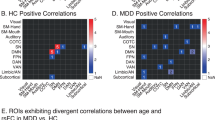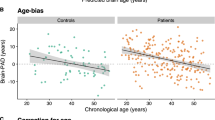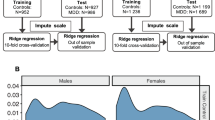Abstract
Volumetric neuroimaging studies of the elderly with affective disorders provide important insights into the underlying physiology of the illnesses. Advantages of studying the elderly include the ability to make various assessments and obtain a history differentiating subtypes of illness. However, challenges to studying the elderly include the heterogeneity of affective illnesses and confounds of medical comorbidity and medications. Volumetric assessments have provided important information in the neural mechanisms of mood regulation, especially in the overlap of cognitive disorders. This article reviews articles describing findings of volumetric analyses in elderly with unipolar depression and bipolar disorders, and compares and contrasts these findings with the larger volumetric research in affective disorders.
Similar content being viewed by others
References and Recommended Reading
Kumar A, Bilker W, Jin Z, et al.: Age of onset of depression and quanititative neuroantomic measures: absence of speci.c correlates. Psychiatry Res: Neuroimaging 1999, 91:101–110.
Cowell PE, Turetsky BI, Gur RC, et al.: Sex differences in aging of the human frontal and temporal lobes. J Neurosci 1994, 14:4748–4755.
Johnstone EC, Crow TJ, Frith CD, et al.: Cerebral ventricular size and cognitive impairment in chronic schizophrenia. Lancet 1976, 2:924–926.
Beyer JL, Krishnan KRR: Neuroimaging in mood disorders. Bipolar Disord 2002, 4:89–104.
Elkis H, Friedman L, Wise A, Meltzer HY: Meta-analyses of studies of ventricular enlargement and cortical sulcal prominence in mood disorders: comparisons with controls or patients with schizophrenia. Arch Gen Psychiatry 1995, 2:735–746.
Soares JC, Mann JJ: The anatomy of mood disorders-Review of structural neuroimaging studies. Biol Psychiatry 1997, 41(1):86–106.
Jacoby RJ, Levy R: Computed tomography in the elderly. 3. Affective disorder. Br J Psychiatry 1980, 136:270–275.
Rabins PV, Pearlson GD, Aylward E, et al.: Cortical magnetic resonance imaging changes in elderly inpatients with major depression. Am J Psychiatry 1991, 148:617–620.
Alexopoulos GS, Young RC, Shindledecker RD: Brain computed tomography findings in geriatric depression and primary degenerative dementia. Biol Psychiatry 1992, 31:591–599.
Wurthman C, Bogerts B, Falkai P: Brain morphology assessed by computed tomography in patients with geriatric depression, patients with degenerative dementia, and normal control subjects. Psychiatry Res 1995, 61:103–111.
Dahabra M, Friedman L, Jesberger J, et al.: A magnetic resonance imaging study of thalamic area in adolescent patients with either schizophrenia or bipolar disorder as compared to healthy controls. Psychiatry Res 1999, 91:155–162.
Pearlson GD, Rabins PV, Kim WS, et al.: Structural brain CT changes and cognitive de.cits in elderly depressives with and without reversible dementia (‘pseudodementia’). Psychol Med 1989, 19:573–584.
Beats B, Levy R, Forstl H: Ventricular enlargement and caudate hyperdensity in elderly depressives. Biol Psychiatry 1999, 45:1S-147S.
Shima S, Shikano T, Kitamura T, et al.: Depression and ventricular enlargement. Acta Psychiatr Scand 1984, 70:275–277.
Morris P, Rapoport SI: Neuroimaging and affective disorder in late life: a review. Can J Psychiatry 1990, 35:347–354.
O’Brien JT, Desmond P, Ames D, et al.: The differentiation of depression from dementia by temporal lobe magnetic resonance imaging. Psychol Med 1994, 24:633–640.
Sheline YI, Sanghavi M, Mintun MA, Gado MH: Depression duration but not age predicts hippocampal volume loss in medically healthy women with recurrent major depression. J Neurosci 1999, 19:5034–5043. Decline in hippocampal volume was not related to age, but was related to total lifetime duration of depression. Findings suggested stress may be related to hippocampal injury.
Kumar A, Zhisong J, Bilker W, et al.: Late-onset minor and major depression: early evidence for common neuroanatomical substrates detected by using MRI. Proc Natl Acad Sci U S A 1998, 95:7654–7658.
Krishnan KRR, McDonald WM, Doraiswamy PM, et al.: Neuroanatomical substrates of depression in the elderly. Eur Arch Psychiatry Neurosci 1993, 243:41–46.
Pantel J, Schroder J, Essig M, et al.: Quantitative magnetic resonance imaging in geriatric depression and primary degenerative dementia. J Affect Disord 1997, 42:69–83.
Pearlson GD, Veroff AE: Computerised tomographic scan changes in manic-depressive illness. Lancet 1981, 2:470.
Nasrallah HA, McCalley-Whitters M, Jacoby CG: Cerebral ventricular enlargement in young manic males. A controlled study. J Affect Disord 1982, 4:15–19.
Pearlson GD, Garbacz DJ, Tompkins RH, et al.: Clinical correlates of lateral ventricular enlargement in bipolar affective disorder. Am J Psychiatry 1984, 141:253–256.
Andreason NC, Swayze V, Flaum M, et al.: Ventricular abnormalities in affective disorder: clinical and demographic correlates. Am J Psychiatry 1990, 147:893–900.
Schlegel S, Kretzschmar K: Computed tomography in affective disorders, part I: ventricular and sulcal measurements. Biol Psychiatry 1987, 22:4–14.
Dewan MJ, Haldipur CV, Lane EE, et al.: Bipolar affective disorder: I. comprehensive quantitative computed tomography. Acta Psychiatr Scand 1988, 77:677–682.
Young RC, Nambudiri DE, Jain H, et al.: Brain computed tomography in geriatric manic disorder. Biol Psychiatry 1999, 45:1063–1065.
McDonald WM, Krishnan KR, Doraiswamy PM, Blazer DG: Occurrence of subcortical hyperintensities in elderly subjects with mania. Psychiatry Res 1991, 40:211–220.
Risch SC, Lewine RJ, Kalin NH, et al.: Limbichypothalamic-pituitary-adrenal axis activity and ventricular-to-brain ratio studies in affective illness and schizophrenia. Neuropsychopharmacology 1992, 6:95–100.
Strakowski SM, Wilson DR, Tohen M, et al.: Structural brain abnormalities in first-episode mania. Biol Psychiatry 1993, 33:602–609.
Harvey I, Persaud R, Ron MA, et al.: Volumetric MRI measurements in bipolars compared with schizophrenics and healthy controls. Psychol Med 1994, 24:689–699.
Hauser P, Matochik J, Altshuler LL, et al.: MRI-based measurements of temporal lobe and ventricular structures in patients with bipolar I and bipolar II disorders. J Affect Disord 2000, 60:25–32.
Rabins PV, Aylward E, Holroyd S, Pearlson GD: MRI findings differentiate between late-onset schizophrenia and late-life mood disorder. Int J Geriatr Psychiatry 2000, 15:954–960.
Roy PD, Zipursky RB, di Michele V, et al.: A computerized tomographic study in patients with depressive disorder: A comparison with schizophrenic patients and controls. Acta Psychiatr Belg 1989, 89:56–61.
Pearlson GD, Barta PE, Powers RE, et al.: Ziskind-Somerfeld Research Award 1996. Medial and superior temporal gyral volumes and cerebral asymmetry in schizophrenia versus bipolar disorder. Biol Psychiatry 1997, 41:1–14.
Tanaka Y, Hazama H, Fukuhara T, Tsutsui T: Computerized tomography of the brain in manic-depressive patients - a controlled study. Folia Psychiatr Neurol Jpn 1982, 36:137–143.
Beyer JL, Kuchibhatla M, Payne M, et al.: Caudate volume measurement in older adults with bipolar disorder. Int J Geriatr Psychiatry 2004, 19:109–114.
Krishnan KR, McDonald WM, Escalona PR, et al.: Magnetic resonance imaging of the caudate nuclei in depression. Preliminary observations. Arch Gen Psychiatry 1992, 49:553–557.
Coffey CE, Wilkinson WE, Weiner RD, et al.: Quantitative cerebral anatomy in depression. A controlled magnetic resonance imaging study. Arch Gen Psychiatry 1993, 50:7–16.
Drevets WC, Price JL, Simpson Jr JR, et al.: Subgenual prefrontal cortex abnormalities in mood disorders. Nature 1997, 386:824–827.
Kumar A, Miller D: Neuroimaging in late-life mood disorders. Clinical Neuroscience 1997, 4:8–15.
Hirayasu Y, Shenton ME, Salisbury DF, et al.: Subjenual cingulate cortex volume in first-episode psychosis. Am J Psychiatry 1999, 156:1091–1093.
Kumar A, Bilker W, Jin Z, Udupa J: Atrophy and high intensity lesions: complementary neurobiological mechanisms in late-life major depression. Neuropsychopharm 2000, 22:264–274.
Lai T-J, Payne ME, Byrum CE, et al.: Reduction of orbital frontal cortex volume in geriatric depression. Biol Psychiatry 2000, 48:971–975.
Bremner JD, Narayan M, Anderson ER, et al.: Hippocampal volume reduction in major depression. Am J Psychiatry 2000, 157:115–117.
Botteron KN, Raichle ME, Heath AC, et al.: An epidemiological twin study of prefrontal neuromorphometry in early onset depression (abstract). Biol Psychiatry 1999, 45:1S-147S.
Rajkowska G, Miguel-Hidalgo JJ, Wei J, et al.: Morphometric evidence for neuronal and glial prefrontal cell pathology in major depression. Biol Psychiatry 1999, 45:1085–1098.
Coffman JA, Bornstein RA, Olson SC, et al.: Cognitive impairment and cerebral structure by MRI in bipolar disorder. Biol Psychiatry 1990, 27:1188–1196.
Haznedar MM, Roversi F, Pallanti S, et al.: Fronto-thalamostriatal gray and white matter volumes and anisotropy of their connections in bipolar spectrum illnesses. Biol Psychiatry 2005, 57:733–742.
Strakowski SM, DelBello MP, Sax KW, et al.: Brain magnetic resonance imaging of structural abnormalities in bipolar disorder. Arch Gen Psychiatry 1999, 56:254–260.
Kumar A, Mintz J, Bilker W, Gottlieb G: Autonomous neurobiological pathways to late-life major depressive disorder: clinical and pathophysiological implications. Neuropsychopharmacology 2002, 26:229–236.
Bell-McGinty S, Butters MA, Meltzer C, et al.: Brain morphometric abnormalities in geriatric depression: long-term neurobiological effects of illness duration. Am J Psychiatry 2002, 159:1424–1427.
Lavretsky H, Kurbanyan K, Ballmaier M, et al.: Sex differences in brain structure in geriatric depression. Am J Geriatr Psychiatry 2004, 12:653–657.
Lavretsky H, Roybal DJ, Ballmaier M, et al.: Antidepressant exposure may protect against decrement in frontal gray matter volumes in geriatric depression. J Clin Psychiatry 2005, 66:964–967. Larger orbital frontal volume in patients treated with antidepressants compared with drug-naïve depressed patients suggests that antidepressant exposure may protect against gray matter loss in geriatric depression.
Taki Y, Kinomura S, Awata S, et al.: Male elderly subthreshold depression patients have smaller volume of medial part of prefrontal cortex and precentral gyrus compared with age-matched normal subjects: a voxel-based morphometry. J Affect Disord 2005, 88:313–320.
Janssen J, Pol HEH, Lampe IK, et al.: Hippocampal changes and white matter lesions in early-onset depression. Biol Psychiatry 2004, 56:825–831.
Shah PJ, Glabus MF, Goodwin GM, Ebmeier KP: Chronic, treatment-resistant depression and right fronto-striatal atrophy. Br J Psychiatry 2002, 180:434–440.
Simpson S, Baldwin RC, Jackson A, Burns A: The differentiation of DSM-III-R psychotic depression in later life from nonpsychotic depression: comparisons of brain changes measured by multispectral analysis of magnetic resonance brain images, neuropsychological findings, and clinical features. Biol Psychiatry 1999, 45:193–204.
O’Brien JT, Ames D, Schweitzer I, et al.: Clinical, magnetic resonance imaging and endocrinological differences between delusional and non-delusional depression in the elderly. Int J Geriatr Psychiatry 1997, 12:211–218.
Altshuler LL, Conrad A, Hauser P, et al.: Reduction of temporal lobe volume in bipolar disorder: a preliminary report of magnetic resonance imaging (letter). Arch Gen Psychiatry 1991, 48:482–483.
Hauser P, Altshuler LL, Berrettini W, et al.: Temporal lobe measurement in primary affective disorder by magnetic resonance imaging. J Neuropsychiatry Clin Neurosci 1989, 1:128–134.
Johnstone EC, Owens DGC, Crow TJ, et al.: Temporal lobe structure as determined by nuclear magnetic resonance in schizophrenia and bipolar affective disorder. J Neurol Neurosurg Psychiatry 1989, 52:736–741.
Swayze VW, Andreason NC, Alliger RJ, et al.: Subcortical and temporal structures in affective disorders and schizophrenia: a magnetic resonance imaging study. Biol Psychiatry 1992, 31:221–224.
Altshuler LL, Bartzokis G, Brieder T, et al.: Amygdala enlargement in bipolar disorder and hippocampal reduction in schizophrenia: an MRI study demonstrating neuranatomic speci.city (letter). Arch Gen Psychiatry 1998, 55:663–664.
Altshuler LL, Bartzokis G, Grieder T, et al.: An MRI study of temporal lobe structures in men with bipolar disorder or schizophrenia. Biol Psychiatry 2000, 48:147–162.
Sheline YI, Gado MH, Price JL: Amygdala core nuclei volumes are decreased in recurrent major depression. Neuroreport 1989, 9:24–36.
Xia J, Chen J, Zhou Y, et al.: Volumetric MRI analysis of the amygdala and hippocampus in subjects with major depression. J Huazhong Univ Sci Technolog Med Sci 2004, 24:500–502, 506.
Ashtari M, Greenwald BS, Kramer-Ginsberg E, et al.: Hippocampal/amygdala volumes in geriatric depression. Psychol Med 1999, 29:629–638.
Pearlson GD, Barta PE, Powers RE, et al.: Medial and superior temporal gyral volumes and cerebral asymmetry in schizophrenia versus bipolar disorder. Biol Psychiatry 1997, 41:1–14.
Sheline YI, Wang PW, Gado MH, et al.: Hippocampal atrophy in recurrent major depression. Proc Natl Acad Sci USA 1996, 93:3908–3913.
Vakili K, Pillay SS, Lafer B, et al.: Hippocampal volume in primary unipolar major depression: a magnetic resonance imaging study. Biol Psychiatry 2000, 47:1087–1090.
Hickie I, Naismith S, Ward PB, et al.: Reduced hippocampal volumes and memory loss in patients with early- and late-onset depression. Br J Psychiatry 2005, 186:197–202.
Steffens DC, Byrum CE, McQuoid DR, et al.: Hippocampal volume in geriatric depression. Biol Psychiatry 2000, 48:301–309.
O’Brien JT, Lloyd A, McKeith I, et al.: A longitudinal study of hippocampal volume, cortisol levels, and cognition in older depressed subjects. Am J Psychiatry 2004, 161:2081–2090. Older subjects have persisting cognitive impairments associated with hippocampal volume reduction, but this does not seem to be related to cortisol-mediated (stress) neurotoxicity.
Lloyd AJ, Ferrier IN, Barber R, et al.: Hippocampal volume change in depression: late- and early-onset illness compared. Br J Psychiatry 2004, 184:488–495.
Taylor WD, Steffens DC, Payne ME, et al.: In.uence of serotonin transporter promoter region polymorphisms on hippocampal volumes in late-life depression. Arch Gen Psychiatry 2005, 62:537–544. Late-onset depressed subjects who were homozygous for the L allele of the serotonin transporter gene had smaller hippocampal volumes than other groups. The genotype mediated the effect of age of onset on hippocampal volumes.
Simpson SW, Baldwin RC, Burns A, Jackson A: Regional cerebral volume measurements in late-life depression: relationship to clinical correlates, neuropsychological impairment and response to treatment. In J Geriatr Psychiatry 2001, 16:469–476.
Steffens DC, Payne ME, Greenberg DL, et al.: Hippocampal volume and incident dementia in geriatric depression. Am J Geriatr Psychiatry 2002, 10:62–71.
Hsieh M-H, McQuoid DR, Levy RM, et al.: Hippocampal volume and antidepressant response in geriatric depression. Int J Geriatr Psychiatry 2002, 17:519–525.
Beyer JL, Kuchibhatla M, Payne ME, et al.: Hippocampal volume measurement in older adults with bipolar disorder. Am J Geriatr Psychiatry 2004, 12:613–620. Hippocampal volume increases in elderly bipolar subjects is not related to age of onset or number of previous episodes, but may be related to the use of lithium.
Husain MM, McDonald WM, Doraiswamy PM, et al.: A magnetic resonance imaging study of putamen nuclei in major depression. Psychiatry Res 1991, 40:95–99.
Greenwald BS, Kramer-Ginsberg E, Bogerts B, et al.: Qualitative magnetic resonance imaging findings in geriatric depression. Possible link between later-onset depression and Alzheimer’s disease? Psychol Med 1997, 27:421–431.
Parashos IA, Tupler LA, Blichington T, Krishnan KR: Magnetic-resonance morphometry in patients with major depression. Psychiatry Res 1998, 84:7–15.
Dupont RM, Jernigan TL, Heindel W, et al.: Magnetic resonance imaging and mood disorders -localization of white matter and other subcortical abnormalities. Arch Gen Psychiatry 1995, 52:747–755.
Kumar A, Gupta RC, Thomas MA, et al.: Biophysical changes in normal-appearing white matter and subcortical nuclei in late-life major depression detected using magnetization transfer. Psychiatry Res Neuroimaging 2004, 130:131–140.
Kim DK, Kim BL, Sohn SE, et al.: Candidate neuroanatomic substrates of psychosis in old-aged depression. Prog Neuro-Psychopharmacol Biol Psychiatry 1999, 23:793–807.
Drevets WC, Ongur D, Price JL: Neuroimaging abnormalities in the subgenual prefrontal cortex: implications for the pathophysiology of familial mood disorders. Molecular Psychiatry 1998, 3:220–226, 190–191.
Sapolsky RM: Glucocorticoids and hippocampal atrophy in neuropsychiatric disorders. Arch Gen Psychiatry 2000, 57:925–935.
Author information
Authors and Affiliations
Corresponding author
Rights and permissions
About this article
Cite this article
Beyer, J.L. Volumetric brain imaging studies in the elderly with mood disorders. Curr Psychiatry Rep 8, 18–24 (2006). https://doi.org/10.1007/s11920-006-0077-0
Issue Date:
DOI: https://doi.org/10.1007/s11920-006-0077-0




